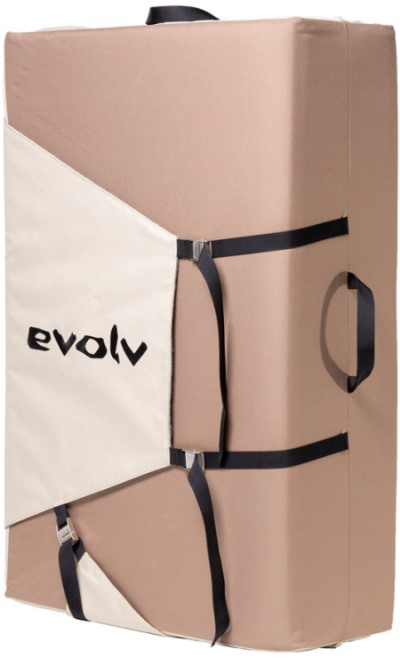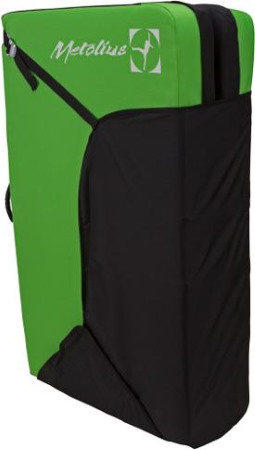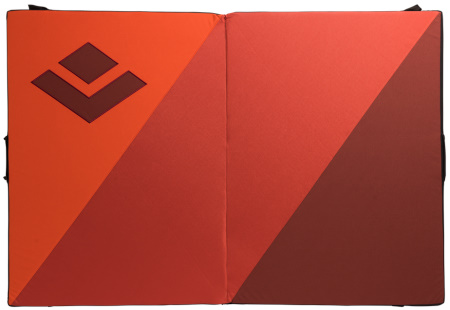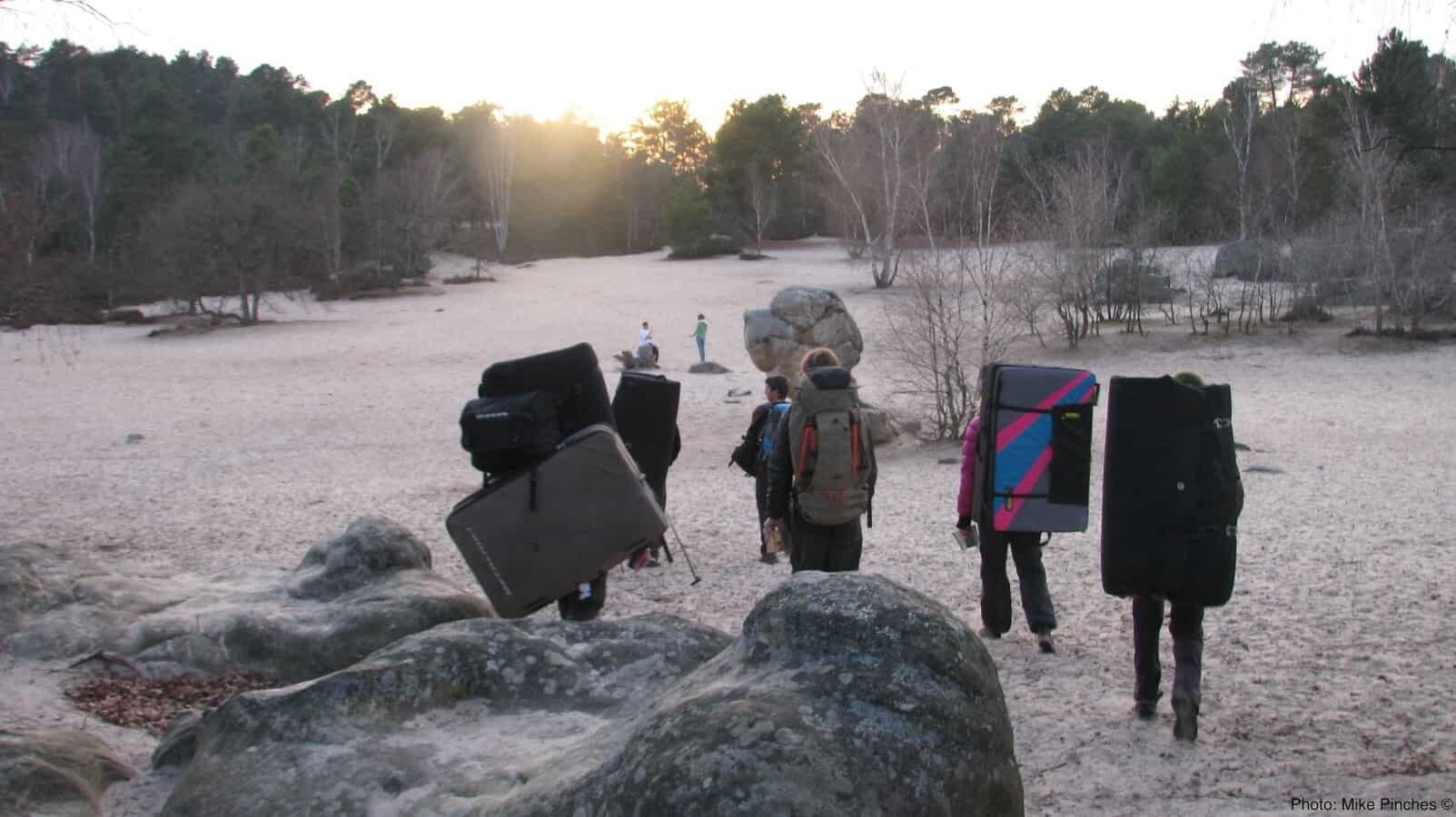Looking at the massive range of crash pads for bouldering beginners starting outside can be a daunting task. We’ve covered everything you need to know in-depth in our “Bouldering Pad Buyer’s Guide”, but today we’ll show you the very best beginner bouldering crash pads to buy right now based on a simple set of rules.
Our simple checklist for a beginner pad:
- Quality Foam – Good foam spreads impact well and will stay firm for years
- Not Too Small – Cover all your options instead of going too small for safety
- Not Too Big – Will fit in most cars and won’t be too heavy to carry in
- Comfy Carry – You don’t need the perfect carry system, just one that keeps the pad secure on hard approaches
- 4 Inches Minimum – A good rule of thumb for most problems. If you do a lot of highball boulders, invest in a thicker 5 inch pad
- Know What You Need – You can get away without storage pockets, welcome mats, velcro systems, or perfect closure zips and buckles.
- Safety First – Make sure you feel safe. You have to trust your pad, don’t get one that might hold you back from trying your best
We’ve included a range of popular and well-tested basic pads below that fill these needs and come out at a great value. Start simply. If you end up getting into bouldering outside in a big way, you’ll know what you want in your next pad and always have a decent one spare – even if it is a bit beaten up.
Read What Is Bouldering?
We would also strongly suggest going to a local store to try out sizing and thickness first before committing to buy. If you find the pad you like in-store often you can ask for a discount. Many places will try to price match online and it supports your local scene.
Just want to get out there?
Our top picks at the cheapest place to buy online
Best Beginner Bouldering Crash Pad – Evolv Drop
Best Budget Crash Pad – Metolius Session II
Best Large Bouldering Crash Pad – Black Diamond Mondo
Best Beginner Bouldering Crash Pad
| Open Size: 48” x 36” (122 cm x 91 cm) | Closed Size: 36” x 24” x 11″(61 x 91 x 28 cm) |
| Thickness: 5″ (12.7 cm) | Weight: 14lbs |
| Foam: 3″ open-cell middle, 1″ closed-cell top and bottom | Hinge: Straight |
| Carry style: Adjustable padded backpack with chest and waist harness | Fabric: 900d Poly Top, 1000d Kordura bottom/side |
The Drop Pad from Evolv is a brand new offering and manages to cover basically everything you’d want in a beginner bouldering crash pad at a great price. It’s the top recommendation in our bigger Best Bouldering Crash Pad article too – for good reason.
Essentially this is a standard-sized pad with a good 5″ thickness, a really comfortable and adjustable carry system, plus some very well-thought-out features. At the price – it’s definitely worth getting over the cheaper pads.
The padded backpack straps are great because of the load-lifter straps, and the chest and waist harnesses make it easy to adjust for most bodies. This makes a big difference on long approaches.
The closure system also functions as a large carpet for cleaning shoes. It’s also really good to cover sit-starts of lower routes where you’d normally sit on the dirty floor. With the suitcase side handle it’s easy to lug between routes, plus three handles for re-adjusting.
The straps are also large enough that you can get a full extra pad strapped in as well. That means you have room for upgrading later.
The Evolv Drop comes in two colors: one blue/grey with a skull design, and one in white/tan. The white will show up dirt easier and the Joshua Tree print looks amazing.
Best Budget Bouldering Crash Pad
| Open Size: 48” x 36” (122 x 91 cm) | Closed Size: 36” x 26″ x 8″ (91 x 66 x 20 cm) |
| Thickness: 4″ (10.2 cm) | Weight: 9lbs |
| Foam: 1″ closed-call top, 2 1/2″ open-cell middle, 1/2″ closed-cell bottom | Hinge: Angled |
| Carry style: Backpack straps with waist belt | Fabric: 900d polyester outer |
The Session II used to be our favorite bouldering crash pad for beginners or anyone looking for a good budget pad. While for not much more you can get more features and a thicker pad in the Evolv Drop, the Session II is still a good contender on a budget.
It comes in at a good standard size and 4 inches of foam in three layers. The closure and pocketed front mean you can stash shoes and chalk bags in an easy-to-access place. There are also a couple of other pockets in the large top flap for keys, phones, and other small bits.
If you want to stash more – you can. As the bottom of the pad is covered when closed, you can safely store a good amount in the middle of the pad as you walk in. The straps are also big enough for another smaller pad like the Metolius Shortstop to cover any gaps.
In terms of features, the middle gutter is angled on both sides and has velcro to keep it close. That means you don’t have to worry about your foot hitting the floor if you land bang in the middle.
There is a big carpet diamond in the middle of the opened pad for cleaning shoes. You can also reverse the closure to cover the backpack straps so they don’t get dirty on the floor.
Overall the Session II is a great pick for the best budget bouldering crash pad at this price, though it’s possible to catch it on sale. It’s also a great extra pad to fit in with something like the Drop, or one of Metolius’ larger pads.
Alternatives?
If you want the same size but in a thicker 5″ pad OR you and a friend are
Best Large Bouldering Crash Pad For Beginners
Black Diamond Mondo
| Open Size: 65” x 44” (165 x 112 cm) | Closed Size: 44” x 32.5” x 10″ (112 x 82 x 25 cm) |
| Thickness: 5″ (12.7 cm) | Weight: 20lbs |
| Foam: Closed-cell top and bottom, open-cell middle | Hinge: Straight |
| Carry style: Backpack straps and padded waist belt | Fabric: PU-coated 1000d Nylon |
If you want to go big early on – the Mondo from Black Diamond has you covered. It’s a good choice if you’re planning to go it solo or you have a few highballs in mind. It’s definitely pricey but at this size, it’s actually the best value.
For highballs, we really recommend 5 inches minimum but ideally a few stacked pads with a big Mondo as the center. It’s got high-quality foam and tough 1000-denier fabric to stop it from ripping on big falls.
The underside has a rubber coating which will help it stick to uneven or angled surfaces better. With sturdy buckles and four big grab handles it has everything you need.
While it doesn’t have a bunch of nice features it does have what you need to feel safe on your first few boulders. This size and thickness are reassuring to have out in the wild.
More Great Climbing Gear Articles
– Best Bouldering Crash Pad
– Best Beginner Climbing Shoes
– Best Beginner Climbing Rope
– Best Beginner Climbing Harness
– Best Climbing Shoes For Kids
How To Start Bouldering Outdoors?
All you need is a bouldering crash pad, decent climbing shoes, chalk, and a bit of knowledge of some local areas. You can buy local guidebooks for the best information. People spend a lot of time and energy finding, cleaning, and documenting areas so you’ll get the best local beta in one place.
You can also search places like mountainproject or ukclimbing for info. Local facebook groups and old-school blogs are also good places to get info. We’d always suggest finding a place with a variety of lower-graded climbs than you’d normally do indoors to start.
What Is The Difference Between Bouldering Outdoors And Indoors?
Outdoors, boulder problems generally start very low, to the point where many are sit-starts. Most holds don’t stick out of the wall but are divots and faults in the rock itself. You’ll also find that footwork is all about finding areas of friction and smearing on the rock.
Some areas like Fontainebleau in France and Joshua Tree in the US are like playgrounds, stacked with boulders close together or within an easy walk. Most other areas are more scattered.
As a result, you’ll find yourself focusing on working just one or two routes in a day. Instead of trying lots of styles, you’ll find technique and perseverance are key to a good day of bouldering outdoors.
Is Bouldering Outdoors Harder?
Yes, it’s just the truth. Bouldering outdoors is almost a completely different thing from bouldering in a gym because of all the style differences and things you’ll need to relearn.
How much harder is bouldering outdoors? A route indoors grade at V3 might see a comparable route outdoors graded as just a V0. It depends on the gym you go to and the area, but indoor routes are graded significantly easier so people can see a clearer progression.
Don’t let it get to you though. Don’t worry about grades, just have fun and try new things. Enjoy being outdoors!
Thinking through how different beta might affect every move might seem pointless to start with, but take your time and you’ll find a way. It’s all about working it out and not just getting numbers in.
How To Be A Good Boulderer?
Going outside on real rock for the first time? It’s a very different game outdoors. These are the most important things you need to know about being a great boulderer out on real rock: –
- Buy a bouldering brush
- Climbing on dirty holds wears down the rock. Brush holds before you climb to remove grit, save the rock, and get better friction.
- Once you’ve climbed, remove all chalk and tick marks you’ve made. The rock should look natural before you leave.
- Don’t go off trail – Trails are set up so only one line of nature is removed. Going off-trail or making new trails can destroy habitats and lead to access problems for everyone.
- Take more trash out then you brought in – Taking out your own trash is the bare minimum. We all make mistakes and drop or forget things, so make up for everyone’s totally human mistakes by taking a few more things you find out with you.
- Don’t leave food – Sandwich crusts, banana skin and orange peel should all be packed and taken home. You’d be surprised how long they take to break and what impact they have on local ecosystems.
- Take up less space – Large areas around popular boulders get decimated, try to keep your pads and footfall close to the boulder.
- Know your area – Most areas have specific restrictions or etiquette. Some areas are closed for certain times, or ban camping or fires in certain spots. Have a quick google, check your guidebook, or ask in the local facebook group before you travel.
- Beware wet rock – Climbing on some type of rock – like sandstone – when it’s rained in the last day or two can destroy holds. Check the local beta before you get named and shamed without knowing better.
- Tunes – Consider leaving the bluetooth speaker at home. If you’re totally alone, sure. If there’s anyone near you, assume it’s annoying them.




11 thoughts on “Best Beginner Bouldering Crash Pads 2022 – 3 Great Options”
Comments are closed.